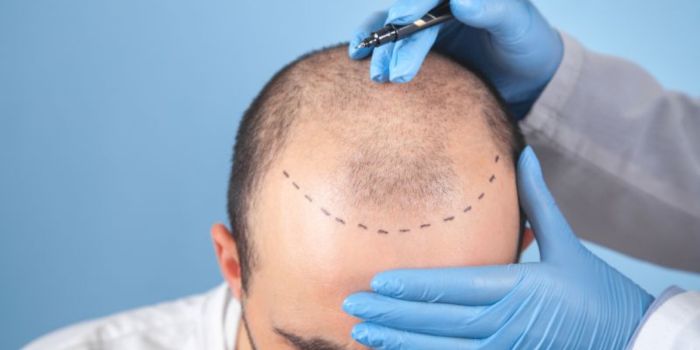Patients frequently ask me to clarify the fundamentals of hair transplantation as I am a hair transplant surgeon with more than 7 years of experience doing follicular unit extraction and follicular unit transplantation surgeries in India. I’ll give a general review of hair transplantation in this post, along with information on the procedures we employ, what to anticipate during surgery, and the healing period. Let’s read below about “How Hair Transplants Work: The Basics Explained”.
Table of Contents
The Goal of Hair Transplant Surgery
Using the patient’s own permanent hair follicles from the back and sides of their scalp—which are genetically resistant to balding—hair transplant surgery aims to restore hair to balding parts of the scalp. This produces long-lasting effects and a natural appearance. I have successfully completed over 2,500 hair transplant treatments for patients with pattern baldness, both male and female, during my career.
How Hair Transplants Work
The permanent zone on the sides and back of the scalp, where genetic balding does not develop, is where healthy hair follicles are harvested. The patient’s original hairline and pattern are then artistically recreated by transplanting these hair follicles into the balding areas on the top of the scalp. Results are permanent since the implanted hair follicles regenerate naturally in the balding areas.
The Primary Two Methods for Hair Transplantation The two main methods for hair transplants that we employ are:
Follicular Unit Extraction (FUE): FUE involves the direct extraction of individual hair grafts from the donor region using a specialized punch tool, followed by transplantation. In the donor area, FUE only produces microscopic dot scars that disappear as the wound heals. In comparison to the strip procedure, it has a quicker recovery period.
Follicular Unit Transplantation (FUT): Also referred to as the strip method, FUT is a procedure that includes removing a thin skin strip from the back of the scalp that contains hair follicles. Under a microscope, the strip is then divided into individual follicular units for transplantation. In the donor location, all that is left is a tiny, linear scar that is readily hidden by the surrounding hair.
During the consultation process, I carefully consider the needs and goals of each patient to determine which approach would yield the best results that seem natural and are customized to their specific hair loss pattern and expectations. I have successfully completed hundreds of patients’ FUE and FUT surgeries throughout the years.
What To Expect During Hair Transplant
Operation Depending on the size of the transplant region, the patient’s hair loss pattern, and the required quantity of grafts, I create a specific surgical plan for each patient, which I go over in detail on the day of the procedure. For optimal comfort, local anesthetic is used to numb the donor and recipient regions.
In FUE, I remove follicular units containing one to four hairs from the donor area using a specialized micromotor punch tool. Before being transplanted, these grafts are kept alive for a short while in a cold saline solution. I carefully use a needle or blade to form tiny recipient sites, then I carefully transplant each follicular unit graft into the balding areas, angling its placement to mimic a natural growth density and direction.
Additionally, a donor strip is extracted under local anesthetic to start the FUT process. My talented surgical assistants carefully cut into this strip to create hundreds of small individual grafts that may contain one or more hairs. These grafts are used to create microscopic recipient sites, which are then creatively transplanted using the same density and angles as natural hair growth.
In my surgical center, a comfortable outpatient process, surgery can be finished in 6-8 hours for fairly sized transplant areas up to 2,500 grafts. If there is significant hair loss, longer sessions spread over two or three days are recommended. Throughout the procedure, I make sure the patients are comfortable and well-hydrated by taking periodic breaks.
Recovery Process and Results Timeline
Following surgery, some swelling, bruising, and mild discomfort are normal; however, adverse effects can be effectively managed with prescription medication. After a FUE operation, patients feel healthy enough to resume their regular activities in two to five days. FUT healing takes a little longer—roughly five to seven days. Within two to three weeks of the transplanted grafts being placed in the telogen (resting) phase, the new hair follicles begin to crust and shed in preparation for future development.
Around three to four months after surgery, the grafted follicles normally start to grow new hair as they enter the anagen (growth) phase. By six months, 50% of patients’ regrowth is apparent. The final, complete outcomes of the transplant are often noticeable 12 to 15 months after FUE surgery and 18 months after FUT surgery. The natural growth of the transplanted hair is a permanent, lifetime outcome.
Conclusion
I hope this summary has made the fundamentals of how hair transplants restore permanent, natural hair growth easier to understand. Over the past few decades, there has been a significant evolution in methodologies, leading to highly polished outcomes. I’m available for individual consultations at all times if you have any more queries. My mission is to create a personalized hair restoration strategy with extreme attention to detail and creativity to meet your specific demands. If you’re thinking about taking the first step toward growing more confident. Fuller hair that you can be happy with, please get in touch. I hope you like reading “How Hair Transplants Work: The Basics Explained”.

Kannaiah Thallapally is a seasoned hair restoration expert with a strong background in advanced hair transplant techniques. As an Associate Member of the International Society of Hair Restoration Surgeons (ISHRS), Kannaiah combines his extensive knowledge with a commitment to the latest industry practices. His expertise is showcased on hairstransplant.in, where he provides valuable insights into hair restoration solutions. Kannaiah is dedicated to helping individuals achieve their desired results and restore their confidence. Connect with him on Instagram for more updates and expert tips.
